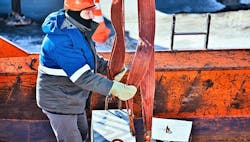As winter approaches, you should assess how well your plant is protected from problems that frigid conditions can pose. Heat-tracing, deadlegs, and other equipment-related aspects certainly require attention. CP articles, e.g., “Get Ready for the Next Big Freeze,” and “Time to Prepare for Winter,” provide useful pointers. Other valuable references include a vintage video from the U.S. Chemical Safety Board, “Prevent Accidents During Subfreezing Weather,” and the blog post “Winter Weather Dangers: Why Winterizing is Crucial for Chemical Plants."
The risk of personnel slipping or falling increases in the winter, as noted in “Winter-proof Your Workplace to Prevent Slips and Falls." Indeed, I am reminded of an incident many years ago involving someone in our department who had a limp. She stepped out of her car on one foot, slipped on some ice and broke her femur.
Let’s look at another aspect that often doesn’t get adequate attention — providing personnel with suitable clothing and other gear.
Consider the experience of my co-worker Fred. His face was bright pink. He had no face mask to provide the minimum of protection against a -10°F windchill. The company jacket he wore was meant for a chilly fall day, not frigid conditions. Moreover, he trudged through the ankle-deep snow in steel-toed boots poorly designed for the real threat that day: frostbite.
It’s hardly an isolated incident. Even with all the tricks I’ve learned over the years, I suffered cracked frost-bitten hands when doing as-built drawings of a plant last winter.
Let’s start with the boots. Your people likely are walking on last year’s tread. Fix that by arranging for new boots every fall. Issue two pairs of heavy wool socks with the boots. For especially cold weather, it is important to keep boots properly waterproofed. Nothing melts snow faster than boot leather — and wet boot leather means wet socks and trench foot. (Thank goodness for good military training.)
Silicon sprays for waterproofing shoes are effective and easy to apply. Old-fashioned treatments like Bear Grease work well, too. Apply product weekly to dry leather.
Also, don’t limit workers to a single pair of work boots. As a minimum, I use two pairs; this allows one pair to dry and gives enough time for an application of boot polish and waterproofer. Make sure there is room for thick socks; add the insert that came with the boots for a spacer in the summer.
Now, look at the pants. Don’t issue work clothes based on measured sizes. Always go up a size. Baggy work pants provide better cooling in the summer and some insulation in the winter. Besides, you can put long underwear on under baggy pants (and an oversized shirt). Also, pay attention to the pockets. I changed pants because I couldn’t fit my hands in the front pockets. This is a good spot to warm fingers if you’re doing something that requires you to take your gloves off.
Don’t skimp. Provide arctic gear, e.g., insulated overalls and proper arctic boots, for workers spending more than half a week in brutally cold conditions.
Face protection also is crucial but more difficult in the age of COVID. An ordinary balaclava won’t do because it allows a gap between your mask and your face. I prefer to wear the mask in place of the balaclava and add a hoodie with a fleeced hood liner for a hard hat. (Note: fire-retardant versions are available.) The trick is to pull the draw strings for the hoodie tight enough to insulate the forehead; this is an area most helmet liners won’t insulate. Now, put on goggles over eyeglasses and leave a gap underneath. Don’t forget your ear plugs — put them on before you tighten the hoodie.
Fogging always is an issue. So, use alcohol lens wipes on all lenses. Masks are a real problem even without goggles. I take my glasses off when I don’t need them for detailed work. I really don’t have a good answer for this except to suggest you keep them close to your body heat, in a case, until you need them; then, they won’t fog as badly.
Lastly, consider warming/cooling stations. Like eye-wash stations, you should have places throughout your facility where workers can heat up or cool down.
About the Author

Dirk Willard
Contributing Editor
DIRK WILLARD is a former ASBPE award-winning columnist for Chemical Processing's Field Notes column. During his 10+ years as a contributing editor for CP, he wrote hundreds of valuable and insightful pieces on design and operational issues. He retired in 2023.
